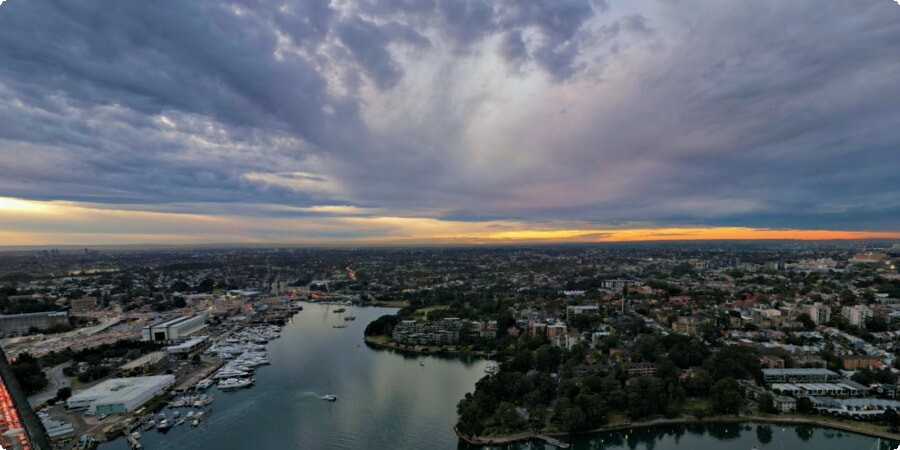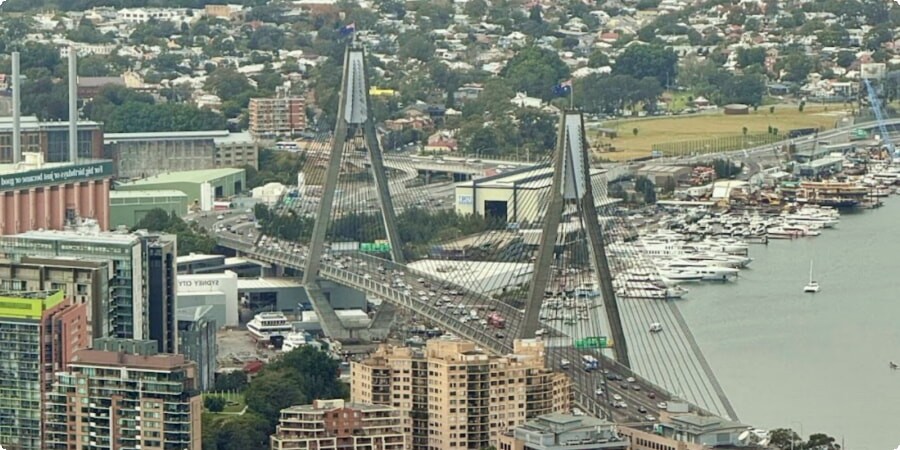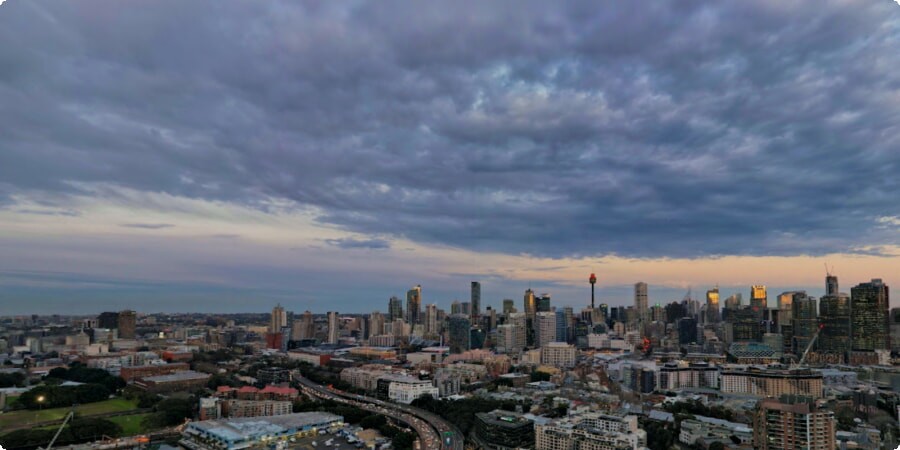Sydney's Anzac Bridge: A Must-See Landmark for Travelers
Sydney's Anzac Bridge stands as one of the city's most recognizable landmarks, a modern marvel that plays a crucial role in connecting the inner suburbs of Sydney with the bustling city center. Spanning the Johnstons Bay between Pyrmont and Glebe Island, this cable-stayed bridge is not just a functional piece of infrastructure; it is a symbol of Australia’s commitment to progress and innovation.
The bridge, named in honor of the Australian and New Zealand Army Corps (ANZAC), pays tribute to the soldiers who served and sacrificed during World War I. Its significance goes beyond its structural grandeur; it is a poignant reminder of the bravery and resilience that are central to the ANZAC spirit. For travelers, visiting the Anzac Bridge is an opportunity to witness a piece of Sydney’s history while enjoying stunning views of the city’s skyline and harbor.
Whether you’re a history enthusiast, an architecture lover, or simply someone who appreciates beautiful vistas, Anzac Bridge offers something for everyone. Its central location and the ease with which it can be accessed make it a must-see for anyone exploring Sydney.
History and Construction of Anzac Bridge
The story of Anzac Bridge begins in the late 1980s, a time when Sydney was experiencing significant growth and needed improved infrastructure to accommodate the increasing flow of traffic. The existing Glebe Island Bridge, a swing bridge built in the early 20th century, was no longer sufficient. Thus, plans were set in motion to construct a new bridge that would not only meet the city’s needs but also stand as a lasting symbol of modern engineering.
Construction of the Anzac Bridge began in 1992 and was completed in 1995. The bridge was officially opened on December 3, 1995, by then Premier of New South Wales, Bob Carr. Its completion marked the end of a massive engineering project that involved over 17,000 tons of concrete, 9,000 tons of steel, and nearly three years of meticulous planning and execution.
Anzac Bridge is notable for its sleek, modern design, characterized by two prominent pylons and 128 cables that fan out to support the bridge deck. At the time of its completion, it was the longest cable-stayed bridge in Australia, with a main span of 345 meters. The bridge’s design not only addressed the city’s transportation needs but also created an iconic structure that would become a part of Sydney’s skyline.
The bridge was initially named the Glebe Island Bridge, but in 1998, it was renamed Anzac Bridge to honor the soldiers of the ANZAC, adding a layer of historical and cultural significance to its already impressive architectural credentials. For those interested in exploring Sydney’s modern history and infrastructure, Anzac Bridge offers a fascinating glimpse into the city’s development during the late 20th century.

Design and Architectural Features
Anzac Bridge is a masterpiece of modern engineering, a testament to the innovative spirit that drives Sydney's infrastructure development. The bridge’s design is both functional and aesthetically pleasing, making it a standout feature in the city’s urban landscape.
The most striking elements of the Anzac Bridge are its two towering pylons, which rise 120 meters above the water. These pylons are the main support structures for the bridge’s deck, with 128 steel cables stretching out in a fan-like pattern to hold up the roadway. This cable-stayed design not only provides the necessary support but also gives the bridge its distinctive and elegant appearance.
One of the unique aspects of Anzac Bridge is its asymmetrical design. The pylons are not centered on the bridge, but rather placed closer to the Pyrmont side, giving the bridge a dynamic and visually interesting profile. This design choice was both an aesthetic and practical decision, allowing for the best possible distribution of weight and stress across the structure.
Walking or driving across the bridge offers a close-up view of these impressive architectural features. The cables, which appear delicate from a distance, are actually massive in scale, each capable of withstanding enormous loads. The bridge’s deck, which spans 805 meters in total, is wide enough to accommodate six lanes of traffic, as well as a dedicated pedestrian and cycle path, making it accessible to all types of travelers.
For those interested in exploring Sydney by car, driving across Anzac Bridge is a great way to experience the city’s layout and architecture firsthand. If you're planning to visit, consider renting a car for a convenient and flexible way to explore not only the bridge but also the many other attractions Sydney has to offer. You can book a car directly from Sydney Airport through this link.
Anzac Bridge’s design is a perfect blend of form and function, creating a structure that is not only essential to Sydney’s transportation network but also a work of art in its own right. Whether viewed from a distance or up close, the bridge’s architectural features are sure to impress any visitor.

Walking Across Anzac Bridge: What to Expect
Walking across Anzac Bridge is an experience that offers a unique perspective of Sydney’s skyline, harbor, and surrounding areas. The pedestrian pathway, located on the northern side of the bridge, is a popular route for both locals and tourists looking to take in the city’s beauty from a different angle.
As you walk along the bridge, you'll be treated to panoramic views of the Sydney Harbour, the Glebe Island, and the ever-evolving cityscape. The best time to embark on this walk is either early in the morning, when the city is just waking up, or in the late afternoon, as the sun begins to set. During these times, the lighting is perfect for capturing stunning photographs, with the city bathed in a warm, golden glow.
The walk across the bridge is approximately 805 meters long, making it a leisurely stroll that can be completed in about 15-20 minutes. Along the way, you'll find several spots where you can pause to take in the view or snap some photos. One of the highlights is the view of the Sydney Tower, which stands out prominently against the skyline, especially when seen from the middle of the bridge.
For those interested in architecture, walking across Anzac Bridge provides an up-close look at the intricate details of the structure, from the massive steel cables to the towering pylons. It's an opportunity to appreciate the engineering marvel that this bridge truly is.
Whether you're a photographer looking for the perfect shot, a history buff interested in Sydney's landmarks, or simply someone who enjoys a scenic walk, crossing Anzac Bridge on foot is an experience not to be missed.
Photography Tips: Capturing Anzac Bridge
Anzac Bridge is a photographer’s dream, offering numerous opportunities to capture stunning images from various angles and perspectives. Whether you're a professional photographer or just someone who loves taking photos, there are a few tips to keep in mind to make the most of your visit.
1. Timing is Key: The best times to photograph Anzac Bridge are during the golden hours—shortly after sunrise and just before sunset. The soft, warm light during these times adds a magical quality to your photos, highlighting the bridge’s structure and the surrounding scenery. Night photography is also rewarding, as the bridge is beautifully illuminated, creating a striking contrast against the dark sky.
2. Explore Different Angles: While the view from the bridge itself is impressive, don’t forget to explore different vantage points around the area. Pyrmont, Rozelle, and the Glebe Foreshore Walk offer excellent spots to capture the bridge from a distance. The reflection of the bridge on the water adds an extra layer of depth to your photos, especially at sunrise or sunset.
3. Use a Tripod for Stability: If you're shooting in low light conditions, such as at dawn, dusk, or night, using a tripod is essential. It helps keep your camera steady, ensuring sharp images even with longer exposure times.
4. Include the Surroundings: Don’t just focus on the bridge—include elements of the surrounding environment in your composition. The Sydney skyline, the harbor, and the nearby boats all add context to your photos, making them more interesting and dynamic.
Whether you're using a DSLR, a smartphone, or any other type of camera, these tips will help you capture the beauty of Anzac Bridge in all its glory. And if you're planning to explore more of Sydney's photographic gems, consider renting a car for easy access to various locations. You can book a car in Australia using this link, ensuring you have the freedom to discover and photograph the city at your own pace.

Anzac Memorials and Tributes
Anzac Bridge is not only an architectural marvel but also a site of deep historical significance. The bridge is adorned with tributes that honor the ANZAC (Australian and New Zealand Army Corps) soldiers who served in World War I. These memorials serve as a poignant reminder of the sacrifices made by these brave men and women and add a layer of solemnity to the bridge’s grandeur.
At the western end of the bridge stands an impressive bronze statue of an Australian World War I digger, gazing out towards the bridge. This statue was unveiled on Remembrance Day in 2000 and is one of the most prominent memorials on the bridge. The digger’s pose, with his head bowed and his rifle resting at his side, conveys a sense of respect and remembrance for those who fought and died for their country.
On the opposite side, at the eastern end of the bridge, a statue of a New Zealand soldier was added in 2008, facing his Australian counterpart. This addition emphasizes the close bond between Australia and New Zealand, especially in the context of their shared military history. The alignment of these statues symbolizes the unity and camaraderie between the two nations, particularly during times of war.
Walking past these memorials, it’s hard not to feel a sense of reverence for the history they represent. For many visitors, these tributes are a highlight of the bridge, offering a moment of reflection amidst the hustle and bustle of city life.
Whether you're visiting to admire the bridge’s architecture or to pay your respects at these memorials, Anzac Bridge is a place where history and modernity converge, offering a unique and meaningful experience for all who cross its span.
Surrounding Areas: Exploring Pyrmont and Rozelle
Anzac Bridge serves as a gateway to some of Sydney’s most vibrant neighborhoods, including Pyrmont and Rozelle. Both areas offer a mix of history, culture, and leisure activities, making them perfect stops for visitors exploring the vicinity of the bridge.
Pyrmont, located at the eastern end of Anzac Bridge, is a lively waterfront suburb that has transformed from its industrial past into one of Sydney's trendiest locales. Here, you'll find a variety of attractions, including the Star Sydney, a world-class casino and entertainment complex. The area is also home to the Sydney Fish Market, one of the largest seafood markets in the Southern Hemisphere, where you can sample fresh seafood or join a guided tour. Pyrmont’s harborside parks and walking paths offer stunning views of the Sydney skyline and are ideal for a leisurely stroll after visiting Anzac Bridge.
On the western side, Rozelle presents a different, more laid-back vibe. Known for its charming streets and historic buildings, Rozelle is a haven for those who appreciate a slower pace. The area is famous for its weekend markets, particularly the Rozelle Collectors Market, where you can browse antiques, vintage clothing, and handmade crafts. Rozelle is also home to several cozy cafés and pubs, perfect for relaxing after a day of sightseeing.
Both Pyrmont and Rozelle offer unique experiences that complement a visit to Anzac Bridge. Whether you're in the mood for the bustling energy of Pyrmont or the quaint charm of Rozelle, you'll find something to enjoy just a short distance from the bridge.

Cycling Over Anzac Bridge: A Scenic Ride
For cycling enthusiasts, Anzac Bridge offers a scenic and enjoyable route that connects Sydney’s inner-west suburbs to the central business district. The bridge’s shared pedestrian and cycling path is well-maintained, making it a popular choice for both commuters and leisure riders.
Starting your ride from Pyrmont, you’ll be treated to impressive views of the city skyline as you ascend the gentle incline of the bridge. The wide, separated path ensures a safe and comfortable ride, whether you're an experienced cyclist or just enjoying a casual outing. As you reach the middle of the bridge, the view opens up to showcase the expanse of Sydney Harbour, with the iconic Sydney Opera House and Harbour Bridge visible in the distance. It’s a perfect spot to pause and take in the view or snap a quick photo.
Continuing towards Rozelle, the path takes you through leafy streets and past historic buildings, offering a peaceful contrast to the busy city on the other side of the bridge. The ride is relatively short, making it ideal for those who want to combine exercise with sightseeing. If you're looking to extend your journey, the surrounding areas of Rozelle and Balmain offer additional cycling routes, including paths along the foreshore and through local parks.
Cycling over Anzac Bridge is not just about the destination but also about enjoying the journey and the views along the way. It’s a must-do for anyone who enjoys exploring Sydney on two wheels.
Night Views of Anzac Bridge: A Different Perspective
Anzac Bridge is a sight to behold at any time of day, but it takes on a special kind of magic after dark. As night falls, the bridge is illuminated by a series of strategically placed lights that highlight its architectural features and create a dramatic contrast against the night sky.
The bridge’s illumination emphasizes the soaring cables and tall pylons, giving it a majestic appearance that is different from its daytime look. The reflections of the lights on the calm waters of the Blackwattle Bay add to the enchantment, creating a mirror-like effect that enhances the visual impact of the bridge.
For the best night views of Anzac Bridge, head to the Glebe Foreshore Walk, which offers an unobstructed vantage point from the water’s edge. Another great spot is Pirrama Park in Pyrmont, where you can see the bridge framed against the city lights. Whether you’re taking a romantic evening stroll or simply enjoying a quiet moment by the water, the night views of Anzac Bridge are sure to leave a lasting impression.
If you’re visiting Sydney, make sure to experience Anzac Bridge both during the day and at night. The contrast between the two offers a complete perspective of this iconic landmark, highlighting its beauty and significance in different lights.